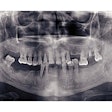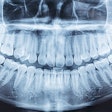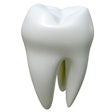Researchers at Princeton University have developed a remote chemical sensor that can detect and transmit messages about a tooth's health, according to an article in Chemistry World.
The graphene-based sensor, which is affixed to the surface of a tooth, is designed to detect bacteria. The device, the first of its kind to interface directly with biological tissue, wirelessly relays information to a detector and has potential as a diagnostic tool, according to its developers.
The technology is commonly used in electronic key cards. In this case, researchers printed a graphene grid on transparent silk, creating a platform that can adhere to a number of surfaces, the article noted.
Once the grid was affixed to a tooth, the layer of silk was dissolved with water, leaving only the graphene. Next, bifunctional peptides were attached to the graphene; one end of the peptide had an affinity for 3 bacterial strains, while aromatic residues at the other served to bind it to the surface of the graphene.
Charged regions in the cell membranes of pathogens and their small electric field are picked up by the graphene, the article explained. By examining the conductance, the bacterial concentration can be determined.
The researchers also hope to measure specific proteins.


















